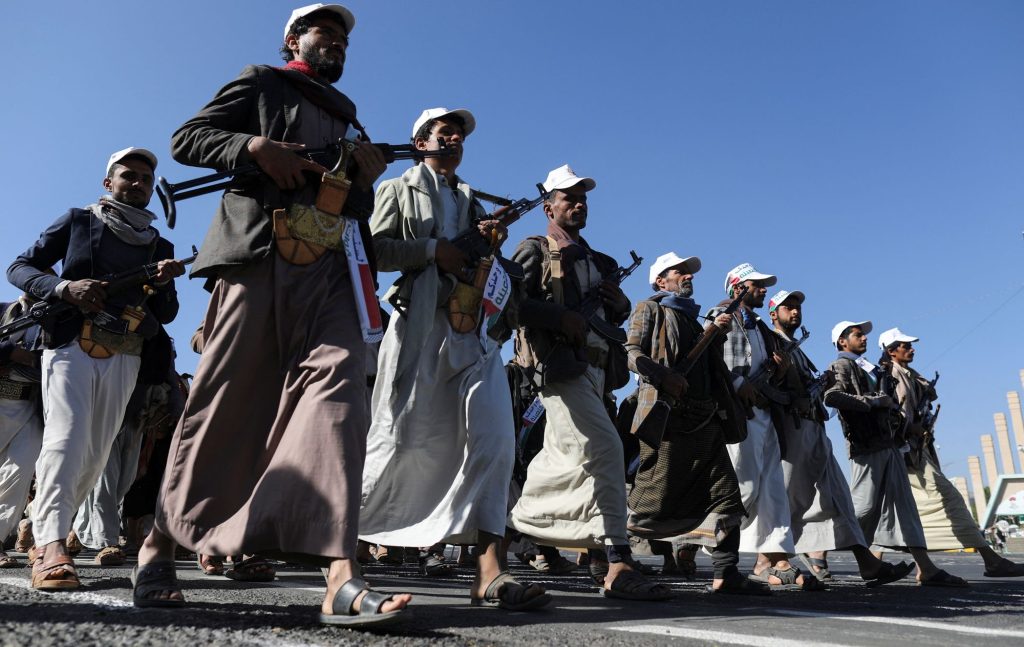By Christian Edwards, CNN
(CNN) — Yemen’s Iran-backed Houthi rebels are stepping up their strikes on ships in the Red Sea, which they say are revenge against Israel for its military campaign in Gaza.
In a significant escalation, the United States and United Kingdom launched strikes against multiple Houthi targets in Yemen, after the Biden administration and its allies warned that the group would bear the consequences of its repeated attacks.
The Houthi attacks have forced some of the world’s biggest shipping and oil companies to suspend transit through one of the world’s most important maritime trade routes, which could potentially cause a shock to the global economy.
The Houthis are believed to have been armed and trained by Iran, and there are fears that their attacks could escalate Israel’s war against Hamas into a wider regional conflict.
Here’s what we know about the Houthis and why they are getting involved in the war.
Who are the Houthis and why is there a civil war in Yemen?
The Houthi movement, also known as Ansar Allah (Supporters of God), is one side of the Yemeni civil war that has raged for nearly a decade. It emerged in the 1990s, when its leader, Hussein al-Houthi, launched “Believing Youth,” a religious revival movement for a centuries-old subsect of Shia Islam called Zaidism.
The Zaidis ruled Yemen for centuries but were marginalized under the Sunni regime that came to power after the 1962 civil war. Al-Houthi’s movement was founded to represent Zaidis and resist radical Sunnism, particularly Wahhabi ideas from Saudi Arabia. His closest followers became known as Houthis.
Yemen’s civil war began in 2014, when Houthi forces stormed the capital Sanaa and toppled the internationally recognized and Saudi-backed government, triggering a civil war. The conflict spiraled into a wider war in 2015 when a Saudi-led coalition intervened in an attempt to beat back the Houthis.
Eight years later, the coalition has been unable to dislodge the Houthis, who remain in control of much of Yemen. A ceasefire was finally signed in 2022, but it lapsed just after six months. Warring parties have not, however, returned to full-scale conflict.
Since the ceasefire, the Houthis have consolidated their control over most of northern Yemen. They have also sought a deal with the Saudis that would bring the war to a permanent end and cement their role as the country’s rulers.
What’s the current situation in Yemen?
The war has sparked one of the world’s worst humanitarian crises, leaving hundreds of thousands dead and pushing parts of the country into famine.
Seventeen million people are currently food insecure in Yemen, the World Food Programme says, warning that the humanitarian situation and lack of food and other crucial supplies have “the potential to bring millions of people closer to starvation and death.”
The conflict also wreaked havoc on the country’s infrastructure, exacerbated economic collapse and led to widespread displacement.
Today, more than 24 million people – over 80% of the population – are in need of humanitarian aid and protection, according to the UN. Some 3 million people have been displaced from their homes, hundreds of thousands have lost their jobs, and more than half of the population is now living in extreme poverty.
The conflict has killed up to round 377,000 people, according to a 2021 report by the United Nations Development Programme (UNDP), more than half of whom died from indirect causes associated with the conflict, such as lack of food, water and healthcare.
So far, only 38.9% of Yemen’s humanitarian funding needs are being met, the United Nations Office for the Coordination of Humanitarian Affairs (OCHA) says, with a funding gap of $2.7 billion still direly needed.
Who are their allies?
The Houthis are backed by Iran, which began increasing its aid to the group in 2014 as the civil war escalated and as its rivalry with Saudi Arabia intensified. Iran has provided the group with weapons and technology for, among other things, sea mines, ballistic and cruise missiles, and unmanned aerial vehicles (UAVs, or drones), according to a 2021 report from the Center for Strategic and International Studies.
The Houthis form part of Iran’s so-called “Axis of Resistance” – an anti-Israel and anti-Western alliance of regional militias backed by the Islamic Republic. Along with Hamas in Gaza and Hezbollah in Lebanon, the Houthis are one of three prominent Iran-backed militias that have launched attacks on Israel in recent weeks.
Tehran on Friday condemned the US-UK strikes against the Houthis, calling it a violation of international law and an attempt to divert attention from the war in Gaza.
How powerful are the Houthis?
American officials have been tracking iterative improvements in the range, accuracy and lethality of the Houthis’ domestically produced missiles. Initially, home-grown Houthi weapons were largely assembled with Iranian components smuggled into Yemen in pieces, an official familiar with US intelligence told CNN previously.
But they have made progressive modifications that have added up to big overall improvements, the official said. In a novel development, the Houthis have used medium-range ballistic missiles against Israel, firing a salvo of projectiles at Israel’s southern region of Eilat in early December, which Israel said it intercepted.
While the Houthis may not be able to pose a serious threat to Israel, their technology can wreak havoc in the Red Sea. They have used drones and anti-ship missiles to target commercial ships – some of which aren’t believed to be linked to Israel – prompting the USS Carney, a warship in the Red Sea, to respond to distress calls.
Why are the Houthis attacking ships in the Red Sea?
While, through a combination of geography and technology, the Houthis may lack the capabilities of Hamas and Hezbollah, their strikes on commercial vessels in the Red Sea may inflict a different sort of pain on Israel and its allies.
The global economy has been served a series of painful reminders of the importance of this narrow stretch of sea, which runs from the Bab-el-Mandeb straits off the coast of Yemen to the Suez Canal in northern Egypt – and through which 12% of global trade flows, including 30% of global container traffic.
In 2021, a ship called the Ever Given ran aground in the Suez Canal, blocking the vital trade artery for nearly a week – holding up as much as $10 billion in cargo each day – and causing disruptions to global supply chains that lasted far longer.
There are fears that the Houthi drone and missile attacks against commercial vessels, which have occurred almost daily since December 9, could cause an even greater shock to the world economy.
Four of the world’s five major shipping firms – Maersk, Hapag-Lloyd, CMA CGM Group and Evergreen – along with oil giants like BP have paused shipping through the Red Sea amid fears of Houthi attacks – moves that caused oil and gas prices to surge.
The attacks could force ships to take a far longer route around Africa and cause insurance costs to rocket. Companies could pass on the increased cost of moving their goods to consumers, raising prices again at a time when governments around the world have struggled to tame post-pandemic inflation.
The Houthi strikes could be intended to inflict economic pain on Israel’s allies in the hope they will pressure it to cease its bombardment of the enclave.
Championing the Palestinian cause could also be an attempt to gain legitimacy at home and in the region as they seek to control northern Yemen. It could also give them an upper hand against their Arab adversaries, Saudi Arabia and the United Arab Emirates, who they accuse of being lackeys of the US and Israel.
How is the world responding?
A number of countries have taken steps to try and push back Houthi aggression in the Red Sea region.
The US and other nations have deployed naval forces to the Red Sea as part of Operation Prosperity Guardian, a new multinational effort consisting of more than 20 countries to safeguard shipping in one of the world’s most critical waterways.
The United Nations Security Council has meanwhile approved a resolution calling on Yemen’s Houthi rebel group to “cease its brazen” attacks in the Red Sea. The vote was 11 in favor, 0 against, and four abstentions, including Russia and China.
The US and Britain have, however, taken their response to a new level with Friday’s strikes on Houthi targets in Yemen. US President Joe Biden said he ordered the strikes “in direct response to unprecedented Houthi attacks against international maritime vessels in the Red Sea.” Biden added that he will “not hesitate to direct further measures to protect our people and the free flow of international commerce as necessary.”
The Houthi spokesperson however said that the group would continue its aggression against commercial ships in the Red Sea. Houthis “will continue to prevent Israeli ships going to the ports of occupied Palestine from navigation in the Arab and Red Seas,” Sare’e said.
Mohammed al-Bukhaiti, a Houthi spokesperson, told Al Jazeera last month that the group would confront any US-led coalition in the Red Sea, and this week’s attacks signal that confrontations in the waterway will continue throughout the new year.
Just as the Biden administration is beginning to yield to pressure for it to push Israel to wind down its campaign in Gaza, the US may find itself being pulled more deeply into the Middle East by the Houthi rebels, who have made themselves impossible to ignore.
The-CNN-Wire
™ & © 2024 Cable News Network, Inc., a Warner Bros. Discovery Company. All rights reserved.






More Stories
Promoting literacy education in Barbados
New type of worker emerging
Bowlers usher Windies A to series win